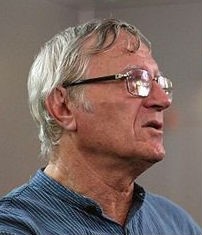
Prof. Felix Aharonian
(Dublin Institute for Advanced Studies, Ireland and
Max Planck Institute for Nuclear Physics, Heidelberg, Germany)
Felix Aharonian is a physicist and astrophysicist who currently conducts his research in Dublin, Ireland and in Heidelberg, Germany. He was born on May 23, 1952, in Yerevan, Armenia. He graduated from Moscow Engineering-Physics Institute. After the Ph.D. degree received from the same institute in 1979, he joined Yerevan Physics Institute, where he conducted his research until 1991. In 1987, he received a degree of Doctor of Sciences. In 1991-1992 he was invited to the University of Chicago, USA, as a visiting researcher. In 1992 he moved to Max Planck Institute for Nuclear Physics (MPIK), Heidelberg, where from 1993 until now he is the Head of High Energy Astrophysics Theory (HEAT) group. Since 2006, after he joined Dublin Institute for Advanced Studies (DIAS), Prof. Aharonian continues to lead the HEAT group in Heidelberg, with a status of External Scientific Member (elected by the Senate of the Max Planck Society). In Dublin, he is a Professor of Astronomy and Astrophysics and Director of the Center for Astroparticle Physics and Astrophysics at DIAS. Prof. Aharonian is a foreign member of the Armenian National Academy of Sciences (2008) and a member of the Royal Irish Academy (2012). He is member of Armenian Astronomical Society and Byurakan Astrophysical Observatory International Science Advisory Committee. The main fields of Prof. Aharonian’s research interests are related to Astroparticle Physics, High Energy Astrophysics, Cosmology, and Theoretical Astrophysics. He is a representative of European Space Agency (ESA) in the JAXA-NASA-ESA X-ray mission ASTRO-H, a member of the Executive Board of the H.E.S.S. collaboration, a member of the KM3NeT Consortium Board. He serves as a member of many international panels and committees, in particular he is the Vice-President of the IAU Division D (High Energy Phenomena and Fundamental Physics), a member of the Scientific Advisory Committee of the Astroparticle Physics European Consortium (APPEC), the Chair of the International Advisory Council of the Institute of Sciences of Cosmos, University of Barcelona, Co-Director of the European Associated Laboratory on High Energy Astrophysics, etc. He is an editor of the International Journal of Modern Physics D. Prof. Aharonian has published more than 650 scientific papers and two books: “Very high energy cosmic gamma radiation: a crucial window on the extreme Universe”, River Edge, NJ: World Scientific Publishing (2004) and (together with C. Dermer and L. Bergstrom) “Gamma ray astronomy at very high energies”, Springer (2013). He has been awarded the Prize of the President of Armenia (2005), EU Decartes prize (as a member of the H.E.S.S. collaboration, 2006), and the Rossi Prize (shared with W. Hofmann and H. Völk, 2010).
|

Prof. Igor Karachentsev
(Special Astrophysical
Observatory, Russia)
|

Prof. Brent Tully
(Institute of Astronomy,
University of Hawaii, USA)
|
|
Igor Karachentsev is a Principal Scientist at Special Astrophysical Observatory (SAO), Russia. He was born on Feb 17, 1940, in Kiev, Ukraine. In 1962 he graduated from Astronomy Department, Physical Faculty, Kiev State University and started his career at Byurakan Astrophysical Observatory (BAO, 1962-1967). He took his Ph.D. degree in 1967 at BAO on the “Dynamical state of systems of galaxies” (advisor V.A. Ambartsumian) and moved to Kiev State University. Since 1971 Prof. Karachentsev works at SAO. In 1973-1975 he was the Vice Director of SAO and in 1975-2006, Head of the Extragalactic Research Laboratory. In 1982 he defended his Doctor of Sciences thesis on the “Dynamics and structure of binary galaxies". Prof. Karachentsev has been member of Scientific Organizing Committee of 20 international meetings, member and secretary of the Time Allocation Committee of the 6m telescope (1977-1992) and is member of International Astronomical Union and Editorial Boards of “Astrofizika” and “Astrophysical Bulletin”. The main fields of Prof. Karachentsev’s research are Dwarf galaxies, Local Volume galaxies, Systems of galaxies, Dark Matter, Galaxy interactions, Galaxy redshifts, Large-scale structure and streamings, Observational Cosmology, and Dark Energy. He has published more than 500 scientific papers, as well as the monograph “Binary galaxies” (Moscow, 1987). He has supervised 14 Ph.D. theses. He has been awarded Senior Honored Scientist of the Russian Federation (2010), F. Bredikhin prize of the Russian Academy of Sciences (2004) and H. Chretien grant of the American Astronomical Society (1999). In 1997-1999 he had a Fellowship in the program of the President of the Russian Federation for supporting of Russian scientists and in 1991-1996, a Fellowship of the Expert Council “Cosmology and Microphysics” of the Russian Academy of Sciences.
|
R. Brent Tully is an astronomer at the Institute for Astronomy at the University of Hawaii since 1975. He was born in 1943 in Toronto, Canada and he received his B.Sc. from the University of British Columbia in 1964 and his Ph.D. from the University of Maryland in 1972. He was a postdoctoral researcher at the Observatoire de Marseille in 1972-1975. He has been visiting astronomer at many leading institutions in Australia, Canada, Chile, France, Germany, Italy, Netherlands, and USA. The main fields of Prof. Tully’s research are extragalactic distance scale, galaxy motions, distribution of dark matter, large scale structure of the universe, luminosity function of galaxies, and dwarf galaxies. He was one of the pioneers of a branch of astronomy so-called Near Field Cosmology related to our understanding of the formation and evolution of galaxies and of the universe itself, with its weblike pattern of filaments of clusters and superclusters separated by vast voids of empty space. In 1977 Prof. Tully and his collaborator J. Richard Fisher discovered a relationship between the mass of galaxies and their luminosities that allow astronomers calculate distances to galaxies, thereby endowing maps of the universe with a third dimension, now well known as Tully-Fisher relation. In 1988, Prof. Tully published The Nearby Galaxies Catalog, along with the Nearby Galaxies Atlas, the first major attempt to illustrate the 3D distribution of galaxies. Using 3D locations approximated from redshifts and a simple model, he mapped 2400 nearby galaxies. He has also published catalogs of directly measured distances, including distances for over 8,000 galaxies, which is the largest assembly of distance currently available (2013). He has published more than 350 scientific papers. He is an honorary member of the Royal Astronomical Society of Canada. He has received a distinguished alumnus award from the University of Maryland and the University of Hawaii Regents Medal for Outstanding Research. He is the winner of Wempe Award from the Leibniz Institute for Astrophysics (Potsdam, Germany, 2014) and awarded Gruber Cosmology Prize (2014, shared with Jaan Einasto, Kenneth Freeman, and Sidney van den Bergh). Prof. Tully is also known for his outreach activities, such as producing and advising documentary films, popular astronomical software, etc.
|
|